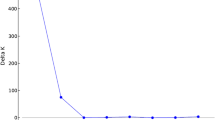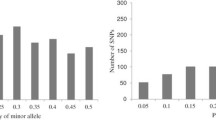Abstract
Microsatellite markers have become one of the most popular tools for germplasm characterization, population genetics and evolutionary studies. To investigate the mutational mechanisms of maize microsatellites, nucleotide sequence information was obtained for ten loci. In addition, Single-Strand Conformation Polymorphism (SSCP) analysis was conducted to assess the occurrence of size homoplasy. Sequence analysis of 54 alleles revealed a complex pattern of mutation at 8/10 loci, with only 2 loci showing allele variation strictly consistent with stepwise mutations. The overall allelic diversity resulted from changes in the number of repeat units, base substitutions, and indels within repetitive and non-repetitive segments. Thirty-one electromorphs sampled from six maize landraces were considered for SSCP analysis. The number of conformers per electromorph ranged from 1 to 7, with 74.2% of the electromorphs showing more than one conformer. Size homoplasy was apparent within landraces and populations. Variation in the amount of size homoplasy was observed within and between loci, although no differences were detected among populations. The results of the present study provide useful information on the interpretation of genetic data derived from microsatellite markers. Further efforts are still needed to determine the impact of these findings on the estimation of population parameters and on the inference of phylogenetic relationships in maize investigations.

Similar content being viewed by others
References
Adams RI, Brown KM, Hamilton MB (2004) The impact of microsatellite electromorph size homoplasy on multilocus population structure estimates in a tropical tree (Corytophora alta) and an anadromous fish (Morone saxatilis). Mol Ecol 13:2579–2588
Anderson TJC, Su X-Z, Roddam A, Day KP (2000) Complex mutations in a high proportion of microsatellite loci from the protozoan parasite Plasmodium falciparum. Mol Ecol 9:1599–1608
Angers B, Bernatchez L (1997) Complex evolution of a salmonid microsatellite locus and its consequences in inferring allelic divergence from size information. Mol Biol Evol 14:230–238
Angers B, Estoup A, Jarne P (2000) Microsatellite size homoplasy, SSCP, and population structure: a case study. Mol Biol Evol 17:1926–1932
Beck NR, Double MC, Cockburn A (2003) Microsatellite evolution at two hypervariable loci revealed by extensive avian pedigrees. Mol Biol Evol 20:54–61
Blankenship SM, May B, Hedgecock D (2002) Evolution of a perfect simple sequence repeat locus in the context of its flanking sequence. Mol Biol Evol 19:1943–1951
Brohede J, Primmer CR, Moller A, Ellegren H (2002) Heterogeneity in the rate and pattern of germline mutation at individual microsatellite loci. Nucleic Acids Res 30:1997–2003
Clark RM, Tavare S, Doebley J (2005) Estimating a nucleotide substitution rate for maize from polymorphism at a major domestication locus. Mol Biol Evol 22:2304–2312
Colson I, Goldstein DB (1999) Evidence for complex mutations at microsatellite loci in Drosophila. Genetics 152:617–627
Culver M, Menotti-Raymond MA, O´Brien S (2001) Patterns of size homoplasy at 10 microsatellite loci in Pumas (Puma concolor). Mol Biol Evol 18:1151–1156
Dellaporta IK, Wood J, Hicks JB (1983) A plant DNA minipreparation: version II. Plant Mol Biol Rep 1:19–21
Di Rienzo A, Peterson AC, Garza JC et al (1994) Mutational processes of simple-sequence repeat loci in human populations. Proc Natl Acad Sci USA 91:3166–3170
Dieringer D, Schlotterer C (2003) Two distinct modes of microsatellite mutation processes: evidence from the complete genomic sequences of nine species. Genome Res 13:2242–2251
Doyle JJ, Morgante M, Tingey SV, Powell W (1998) Size homoplasy in chloroplast microsatellites of wild perennial relatives of Soybean (Glycine subgenus Glycine). Mol Biol Evol 15:215–218
Ellegren H (2004) Microsatellites: simple sequences with complex evolution. Nat Rev Genet 5:435–445
England PR, Usher AV, Whelan RJ, Ayre DJ (2002) Microsatellite diversity and genetic structure of fragmented populations of the rare, fire-dependent shrub Grevillea macleayana. Mol Ecol 11:967–977
Estoup A, Cornuet JM (1999) Microsatellite evolution: inferences from population data. In: Goldstein D, Schlotterer C (eds) Microsatellites: evolution and applications. Oxford University Press, New York, pp 49–65
Estoup A, Jarne P, Cornuet J-M (2002) Homoplasy and mutation model at microsatellite loci and their consequences for population genetics analysis. Mol Ecol 11:1591–1604
Hale ML, Borland AM, Gustafsson MHG, Wolff K (2004) Causes of size homoplasy among chloroplast microsatellites in closely related Clusia species. J Mol Evol 58:182–190
Higgins DG, Thompson JD, Gibson TJ (1994) CLUSTAL W: improving the sensitivity of progressive multiple sequence alignment through sequence weighting, position-specific gap penalties and weight matrix choice. Nucleic Acids Res 22:4673–4680
Kimura M, Ohta T (1978) Stepwise mutation model and distribution of allelic frequencies in finite populations. Proc Natl Acad Sci USA 75:2868–2872
Laborda PR, Oliveira KM, Garcia AAF, Paterniani ME, de Souza AP (2005) Tropical maize germplasm: what can we say about its genetic diversity in the light of molecular markers? Theor Appl Genet 111:1288–1299
Le Clerc V, Bazante F, Baril C, Guiard J, Zhang D (2005) Assessing temporal changes in genetic diversity of maize varieties using microsatellite markers. Theor Appl Genet 110:294–302
Lia VV, Confalonieri VA, Ratto N, Cámara Hernández J, Miante-Alzogaray AM, Poggio L, Brown TA (2007) Microsatellite typing of ancient maize: insights into the history of agriculture in southern South America. Proc Biol Sci 274(1609):545–554
Makova K, Nekrutenko A, Baker RJ (2000) Evolution of microsatellite alleles in four species of mice (Genus Apodemus). J Mol Evol 51:166–172
Matsuoka Y, Mitchell SE, Kresovich S, Goodman MM, Doebley JF (2002a) Microsatellites in Zea—variability, patterns of mutations, and use for evolutionary studies. Theor Appl Genet 104:436–450
Matsuoka Y, Vigouroux Y, Goodman MM et al (2002b) A single domestication for maize shown by multilocus microsatellite genotyping. Proc Natl Acad Sci USA 99:6080–6084
Mogg R, Batley J, Hanley S, Edwards D, O’Sullivan H, Edwards KJ (2002) Characterization of the flanking regions of Zea mays microsatellites reveals a large number of useful sequence polymorphisms. Theor Appl Genet 105:532–543
Navascués M, Emerson BC (2005) Chloroplast microsatellites: measures of genetic diversity and the effect of homoplasy. Mol Ecol 14:1333–1341
Orita M, Iwahana H, Kanazawa H, Hayashi K, Sekiya T (1989) Detection of polymorphisms of human DNA by gel electrophoresis as Single-Strand Conformation Polymorphisms. Proc Natl Acad Sci USA 86:2766–2770
Orti G, Pearse DE, Avise JC (1997) Phylogenetic assessment of length variation at a microsatellite locus. Proc Natl Acad Sci USA 94:10745–10749
Pressoir G, Berthaud J (2004) Patterns of population structure in maize landraces from the Central Valleys of Oaxaca in Mexico. Heredity 92:88–94
Primmer CR, Saino N, Moller AP, Ellegren H (1998) Unraveling the processes of microsatellite evolution through analysis of germ line mutations in barn swallows Hirundo rustica. Mol Biol Evol 15:1047–1054
Reif JC, Xia XC, Melchinger AE et al (2004) Genetic diversity determined within and among CIMMYT maize populations of tropical, subtropical, and temperate germplasm by SSR markers. Crop Sci 44:326–334
Reif JC, Hamrit S, Heckenberger M et al (2005) Genetic structure and diversity of European flint maize populations determined with SSR analyses of individuals and bulks. Theor Appl Genet 111:906–913
Saltonstall K (2003) Microsatellite variation within and among North American lineages of Phragmites australis. Mol Ecol 12:1689–1702
Santacruz-Varela A, Widrlechner MP, Ziegler KE et al (2004) Phylogenetic relationships among North American Popcorns and their evolutionary links to Mexican and South American Popcorns. Crop Sci 44:1456
Stumm G, Vedder H, Schlegel J (1997) A simple method for isolation of PCR fragments from silver stained polyacrylamide gels by fine needle scratching. Elsevier Trends Journals Technical Tips On Line. http://www.tto.biomednet.com/cgi-bin/tto/pr
Sunnucks P, Wilson A, Beheregaray LB et al (2000) SSCP is not so difficult: the application and utility of single-stranded conformation polymorphism in evolutionary biology and molecular ecology. Mol Ecol 9:1699–1701
Symonds VV, Lloyd AM (2003) An analysis of microsatellite loci in Arabidopsis thaliana: mutational dynamics and application. Genetics 165:1475–1488
Taylor JS, Sanny JSP, Breden F (1999) Microsatellite allele size homoplasy in the Guppy (Poecilia reticulata). J Mol Evol 48:245–247
van Oppen JH, Rico C, Turner GF, Hewitt GM (2000) Extensive homoplasy, nonstepwise mutations and ancestral polymorphisms at a complex microsatellite locus in lake Malawi Ciclids. Mol Biol Evol 17:489–498
Viard F, Franck P, Dubois M, Estoup A, Jarne P (1998) Variation at microsatellite size homoplasy across electromorphs, loci, and populations in three invertebrate species. J Mol Evol 47:42–51
Vigouroux Y, Jaqueth JS, Matsuoka Y et al (2002) Rate and pattern of mutation at microsatellite loci in maize. Mol Biol Evol 19:1251–1260
Warburton ML, Xianchua X, Crossa J et al (2002) Genetic characterization of CIMMYT inbred lines and open pollinated populations using large scale fingerprinting methods. Crop Sci 42:1832–1840
Xie H, Sui Y, Chang F-Q, Xu Y, Ma R-C (2006) SSR allelic variation in almond (Prunus dulcis Mill.). Theor Appl Genet 112:366–372
Yokoyama J, Fukuda T, Yokoyama A, Nakajima M (2004) Extensive size homoplasy at a microsatellite locus in the Japanese bumblebee, Bombus diversus. Entomol Sci 7:189–197
Acknowledgments
We thank the late Dr. C. Naranjo, Ing. J. Cámara Hernández and Ing. A.M. Miante Alzogaray for providing us with the material and for carrying out the taxonomic classification of the landraces included in this study. We are also in debt to the reviewers who have greatly improved this manuscript. Several grants from the Consejo Nacional de Investigaciones Científicas y Técnicas (PIP 02296), the University of Buenos Aires (EX–317) and the Agencia Nacional de Promoción Científica y Tecnológica (BID 1201 OC-AR PICT 04443) are gratefully acknowledged.
Author information
Authors and Affiliations
Corresponding author
Additional information
Communicated by M. Bohn.
Electronic supplementary material
Below is the link to the electronic supplementary material.
Rights and permissions
About this article
Cite this article
Lia, V.V., Bracco, M., Gottlieb, A.M. et al. Complex mutational patterns and size homoplasy at maize microsatellite loci. Theor Appl Genet 115, 981–991 (2007). https://doi.org/10.1007/s00122-007-0625-y
Received:
Accepted:
Published:
Issue Date:
DOI: https://doi.org/10.1007/s00122-007-0625-y




